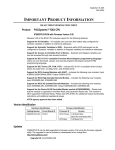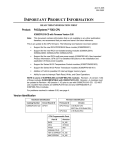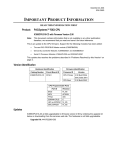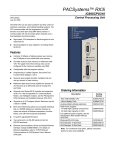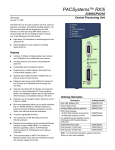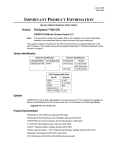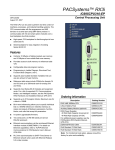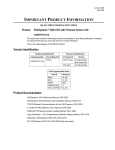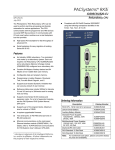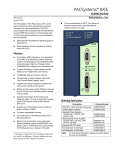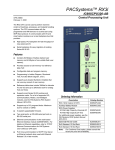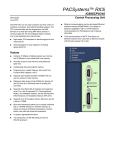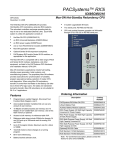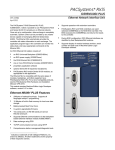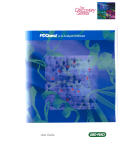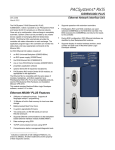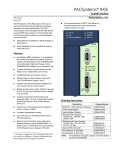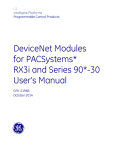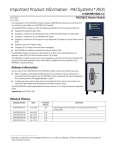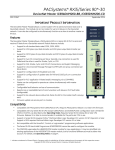Download PACSystems RX3i CPUs, IC695CPU310
Transcript
May 24, 2006
GFK-2329P
IMPORTANT PRODUCT INFORMATION
READ THIS INFORMATION FIRST
Product:
PACSystems™ RX3i CPU
IC695CPU310-EL CPU Module
Firmware Version 3.81
Release 3.81 of the RX3i CPU firmware provides support for eight RX3i Ethernet Interface modules in the
PLC main rack.
Updates
IC695CPU310 can be field-upgraded to firmware version 3.81 using the firmware upgrade utility. The
upgrade kit can be ordered or downloaded at no charge from http://www.gefanuc.com/
Upgrade Kit: 44A752290-G13
Product Documentation
PACSystems CPU Reference Manual, GFK-2222
PACSystems RX3i Hardware and Installation Manual, GFK-2314
TCP/IP Ethernet Communications for the PACSystems, GFK-2224
C Toolkit for PACSystems User’s Manual, GFK-2259
DeviceNet Modules for PACSystems RX3i and Series 90-30 User’s Manual, GFK-2196
IPI, DeviceNet Modules for PACSystems RX3i and Series 90-30, GFK-2194C
Proficy™ Machine Edition Getting Started, GFK-1868
Proficy Logic Developer – PLC Programming Software Getting Started, GFK-1918
Datasheet, PACSystems RX3i CPU, GFK-2316
IPI, PACSystems RX3i CPU, GFK-2329P (this document)
2
Important Product Information
GFK-2329P
CPU Functional Compatibility
Subject
Description
Programmer Version
Requirements
Proficy® Machine Edition Logic Developer 5.5 with Service Pack 1 must be used to
configure eight Ethernet Interface modules with the RX3i CPU.
Proficy Machine Edition Logic Developer 5.5 or later must be used for new features in
PACSystems 3.50 and later.
Proficy Machine Edition Logic Developer 5.0 or later must be used to configure and
program the RX3i. Service Pack 3 is required to support the new features in PACS
3.00.
C Toolkit Compatibility
C Toolkit Release 3.50 Build 34A1 is required for new features in PACSystems
Release 3.50 and later (Use of variables in C Blocks).
The C Toolkit for PACSystems is distributed with Proficy® Machine Edition Logic
Developer 5.0 or greater. Toolkit Release 2.50 build 50A1 or later is required for use
with the RX3i. Please note: The Series 90 Toolkit (IC641SWP709/719) is not
compatible with PACSystems.
Series 90-30 Module
Compatibility
The following Series 90-30 modules are supported by the PACSystems RX3i:
Discrete Input Modules:
IC693ACC300, IC693MDL230/231/240/241/250/260/632/634/645/646/648/654/655
IC693MDL660 – To operate in a CPU Release 3.0 system, the module firmware
must be updated to version 1.10
Discrete Output Modules:
IC693MDL310/330/340/350/390/730/731/732/733/734/740/741/742/748/752/753/7
60/930/931/940
IC693MDL754 – To operate in a CPU Release 3.0 system, the module firmware
must be updated to version 1.10
Discrete Combinational: IC693MAR590, IC693MDR390
Analog I/O Modules: IC693ALG220/221/222/223/390/391/392/442
High Speed Counter: IC693APU300
FANUC I/O Link: IC693BEM320, IC693BEM321
Motion Control: IC693DSM314, IC693DSM324
GENIUS: IC693BEM331
DeviceNet Master: IC693DNM200
Serial IO Processor: IC693APU305
Temperature Control: IC693TCM302, IC693TCM303
Power Transducer: IC693PTM100, IC693PTM101
All other Series 90-30 modules are currently not supported.
Important Product Information
3
GFK-2329P
Subject
Description
IC694 (blue) Module
Compatibility
Discrete Input Modules:
IC694ACC300, IC694MDL230/231/240/241/250/260/632/634/645/646/654/655
IC694MDL660 – To operate in a CPU Release 3.0 system, the module firmware
must be updated to version 1.10
Discrete Output Modules:
IC694MDL310/330/340/350/390/732/734/740/741/742/752/753/930/931/940
IC694MDL754 – To operate in a CPU Release 3.0 system, the module firmware
must be updated to version 1.10
Analog I/O Modules: IC694ALG220/221/222/223/390/391/392/442
High Speed Counter: IC694APU300
Motion Control: IC694DSM314, IC694DSM324
Expansion Backplanes: IC694CHS392/398
Expansion Power Supplies: IC694PWR321/330/331
FANUC I/O Link: IC694BEM320, IC694BEM321
GENIUS: IC694BEM331
Device Net Master: IC694DNM200
Serial IO Processor: IC694APU305
IC695 (PCI) Module
Compatibility
Ethernet Interface: IC695ETM001
Universal Analog Input Module: IC695ALG600
PROFIBUS: IC695PBM300 (Master)
PROFIBUS: IC695PBS301 (Slave)
Non-isolated Analog Input Modules: IC695ALG616/608
Non-isolated Analog Output Modules: IC695ALG708/704
Analog Input Modules with HART: IC695ALG626/628
Analog Output Module with HART: IC695ALG728
Series 90-30 Expansion Rack
Compatibility
Series 90-30 expansion racks, both local and remote, are supported by the
PACSystems RX3i.
PACSystems RX3i CPU does not operate in a Series 90-30 Rack.
Series 90-30 Main Rack
Compatibility
Series 90-30 Main Racks cannot be used in a PACSystems RX3i system.
Series 90-30 CPUs do not operate in PACSystemsRX3i Racks.
Isolated 24V power
In applications that use the IC69xALG220/221/222, consult PACSystems RX3i
Hardware and Installation Manual, GFK-2314 for details of wiring the 24V power.
In Release 3.0, the behavior of the COMMREQ fault output on a COMMREQ sent to
the PROFIBUS master module IC695PBM300 has been changed to be compatible
with the Series 90-30 CPU366 PROFIBUS Master. Previously, the fault output is
enabled when the module receives a COMMREQ and it is busy. Now, the busy
condition does not result in the fault output enabled.
COMMREQ to PBM300
Recommended IC200ALG240
revision
Configuration of
IC694MDL754
When a VersaMax™ system Genius® Network Interface Unit (IC200GBI001)
interoperates with a Genius Bus Controller located in a PACSystems PLC, and the
VersaMax system contains an IC200ALG240 Analog Input Module, it is
recommended to update the IC200ALG240 firmware to Revision 1.10 or later. Use
firmware update kit 44A752313-G01, available in Knowledge Base Article i023269 at
http://globalcare.gefanuc.com.
Always configure 16 bits of module status when using this module. Configuring 0 bits
of module status will result in invalid data in the module’s ESCP status bits.
4
Important Product Information
GFK-2329P
Problems Resolved in Release 3.81
The following problems are resolved in version 3.81 of the CPU firmware.
Subject
Description
Battery Fault Reporting
When a battery is replaced, or sometimes when a battery is low, the user’s logic
may not be retained during a power cycle, although the battery appears to be
functioning correctly at powerup. A new fault (Group 7, Error Code 130) has been
added to indicate that user memory was not preserved over the power-cycle. If this
fault occurs on a power cycle when the battery was not detached, the battery is bad
and should be replaced.
I/O Modules in Expansion
Rack Lost on Rack Powerup
If an expansion rack is powered up after the main rack and before the main rack
has completely powered-up, modules in the rack are no longer lost and I/O is
handled correctly.
Configuring Missing
Ethernet Interface Modules
If EGD is configured for three or more Ethernet modules that are not physically
present in the backplane, the CPU operates correctly during a store of the hardware
configuration and during power-up.
CPU Restrictions and Open Issues
Subject
Description
Battery installation
When installing a new battery, when there currently is no battery installed, the
battery must be installed while the CPU has power. Failing to follow this
procedure could result in the CPU not powering up.
If a battery is installed while power is off (and there was no battery previously
installed), and the CPU fails to power up, simply remove the battery, power cycle
the CPU and then install the battery.
Hot Swapping some Analog
modules slowly may result
in modules not being
recognized
Occasionally during a hot insertion (hot swap) of IC695 Non-Isolated Analog Input
Modules, input channels may take up to 2 seconds to reflect actual input values
after the module OK bit is enabled in the module status word. This delay has only
occurred when the hot insertion has been done slowly (i.e. approximately 1.5
seconds to insert the module)
Ethernet Disconnect During
Word-for-Word Change
If the Ethernet connection is broken during a word-for-word change, the
programmer may not allow a subsequent word-for-word change after
reconnecting due to the fact that it thinks another programmer is currently
attached. If this occurs, you should go offline and then back online again.
Simultaneous Clears, Loads
and Stores Not Supported
Currently, PACSystems CPUs do not support multiple programmers changing
CPU contents at the same time. The programming software may generate an
error during the operation. Simultaneous loads from a single PLC are allowed.
Power Cycle During Write to
Flash
If the CPU is power cycled during the process of writing to flash, and is configured
to power up from flash, a fault will be generated on power up.
Hardware Configuration Not
Equal After Changing Target
Name
If the user stores a hardware configuration to flash that sets “Logic/Config Power
up Source” to “Always Flash” or “Conditional Flash” and then subsequently
changes the name of the target in the programming software, the hardware
configuration will go Not Equal and will not Verify as equal.
PLC and IO Fault Tables
May Need to be Cleared
Twice to Clear Faulted State
Both PLC and IO fault tables may need to be cleared to take the CPU out of
Stop/Fault mode. If one of the tables contains a recurring fault, the order in which
the tables is cleared may be significant. If the CPU is still in Stop/Fault mode after
both tables are cleared, try clearing the fault tables again.
Setting Force On/Off by
Storing Initial Value
Once a force on or force off has been stored to the PLC, the user cannot switch
from force on to force off or vice-versa directly by downloading initial values. The
user can turn off the force by doing a download, and then change the force on or
off by another download.
Number of Active Programs
Returned as Zero
The SNP request Return Controller Type and ID currently returns the number of
active programs as zero.
Important Product Information
5
GFK-2329P
Subject
Description
Serial I/O Failure at 115K
During Heavy Interrupt Load
Rare data corruption errors have been seen on serial communications when
running at 115K under heavy interrupt load on the PLC. Under heavy load
applications, users should restrict serial communications to 57K or lower.
SNP ID not always provided
Unlike the Series 90-30, the RX3i CPU’s SNP ID will not appear in the Machine
Edition programmer Show Status display. Service Request 11 will always return
zeros.
Second programmer can
change logic while in Test &
Edit mode
While currently active in a Test and Edit session using Machine Edition on one
PC, Machine Edition running on another PC is not prevented from storing new
logic to the PLC.
Must Have Logic If
Powering-Up From Flash
If the application will configure the CPU to retrieve the contents of flash memory at
power-up, be sure to include logic along with hardware configuration when saving
to flash memory.
CPU may not detect lowbattery condition
PACSystems CPUs may not detect a low-battery condition early enough to
provide a meaningful warning to the user to replace the battery. A battery with
very low capacity may still have a terminal voltage high enough to report that it is
a good battery. In this case, when the battery starts supplying the memory power
(battery backup), the battery voltage would quickly drop to unacceptable levels,
with little warning to the user before failure.
To insure against data loss, users should replace batteries in accordance with the
guidelines provided in the CPU Reference Manual, GFK-2222. Additionally, users
could save logic and hardware configuration to flash.
Two loss of module faults
for Universal Analog Module
Occasionally, the hot removal of the Universal Analog Input Module
(IC695ALG600) results in two “Loss of I/O Module” faults instead of one.
Power up of HSC may take
as long as 20 seconds
As power is applied to a 90-30 High-Speed Counter, the "module ready" bit in the
status bits returned each sweep from the module may not be set for as long as 20
seconds after the first PLC sweep, even though there is no "loss of module"
indication. I/O data exchanged with the module is not meaningful until this bit is
set by the module. For details, see “Data Transfer Between High Speed Counter
and CPU” in the Series 90-30 High Speed Counter User’s Manual, GFK-0293C.
Info fault at power up
Intermittently during power-up, an Informational non-critical CPU software fault
may be generated with fault extra data of 01 91 01 D6. This fault will have no
effect on the normal operation of the PLC. But, if the hardware watchdog timer
expires after this fault and before power has been cycled again, then the outputs
of I/O modules may hold their last state, rather than defaulting to zero.
Extended Memory Types for
IO Triggers
%R, %W and %M cannot be used as IO triggers.
Possible Machine Edition
inability to connect
Infrequently, an attempt to connect a programmer to a PLC via Ethernet will be
unsuccessful. The normal connection retry dialog will not be displayed. Rebooting
the computer that is running the programmer will resolve the behavior.
SNP Update Datagram
message
If an Update Datagram message requests 6 or less bits or bytes of data, the PLC
will return a Completion Ack without Text Buffer. The protocol specifies that the
returned data will be in the Completion Ack message, but it may not be.
GBC30 may not resume
operation after power cycle
In rare instances, a GBC30 in an expansion rack may not resume normal
operation after a power cycle of either the expansion rack or the main rack.
Configuration of third-party
modules
Do not specify a length of 0 in the configuration of a third-party module. The
module will not work properly in the system.
Power supply status after
CPU firmware update
The PLC will report a “Loss of or missing option module” fault for the
IC695PSD140 RX3i power supply following an update of PLC CPU firmware.
Also, the slot will appear empty in the programmer’s online status detail view. The
power supply continues to operate normally. Power cycle to restore normal status
reporting.
Power supply status after
power cycling
Rarely, turning a power supply on or off may not result in an add or loss fault.
Also, the slot will appear empty in the programmer’s online status detail view. The
power supply continues to operate normally. Power cycle to restore normal status
reporting.
6
Important Product Information
GFK-2329P
Subject
Description
“Clear All” operation may
timeout
A Clear All to a system with a very large hardware configuration may timeout, with
the error:
Error 8097: Server Error - Transfer Error: Host driver timed out. [0x6A][0x01]
The selected memory could not be cleared
ME does not disconnect when the error occurs and a retry is usually successful.
Don’t use multiple targets
In a system in which the hardware configuration is stored from one target and
logic is stored from a different target, powering-up from flash will not work. The
observed behavior is that, following a power up from flash, ME reports hardware
configuration and logic "not equal".
Missing “Loss of terminal
block” fault
The IC695ALG600/608/616 analog input modules do not produce a “Loss of
terminal block” fault when hardware configuration is stored or the module is hotinserted, and the terminal block is not locked into place.
Sequence Store Failure
In systems with very large hardware configurations, it is possible to encounter a
“PLC Sequence Store Failure” error when writing the configuration to flash. To
work around this error, either:
1. Perform an explicit clear of flash prior to performing the write.
2. Increase the operation timeout used by Machine Edition software prior to
performing the write.
IC694MDL754: Must
configure module status
bits
Always configure 16 bits of module status when using this module. Configuring 0
bits of module status will result in invalid data in the module’s ESCP status bits.
IC695ALG600 Lead
Resistance Compensation
setting
A configuration store operation will fail if a channel is configured for 3-wire RTD
and Lead Resistance Compensation is set to Disabled. A Loss of Module fault will
be logged in the I/O Fault table at the end of the store operation. To recover the
lost module, the configuration must be changed to enable Lead Resistance
Compensation and module must be power cycled.
C Toolkit PlcMemCopy
Documentation Incorrect
This routine does allow the destination and source pointers to be outside of
reference memory. If the destination points to discrete reference memory,
overrides and transitions will be honored. Note that the header for PlcMemCopy
has been updated in Release 3.50 of the C toolkit.
Genius Device I/O Enable
LED Does Not Illuminate If
No Output Module Present
on Genius Bus
If a Genius Bus contains no output Genius devices, the I/O Enable LEDs for the
input Genius devices will not illuminate when the PLC is placed in RUN Mode.
The modules will function properly even though the status LED is not lit. If an
output Genius device is present on the Genius bus, the I/O Enable LED will
illuminate for all input and output Genius devices when the PLC is placed in RUN
Mode as expected.
Issues Related to the IC695ALG626/628/728 Analog Modules with HART
HART Input Modules are not
Re-acquired after CPU Firmware
Update
After WinLoading Firmware to the RX3i CPU, Analog Input modules with HART,
IC695ALG626 and IC695ALG628, are not reacquired by the CPU. Loss of
module faults are logged in the fault table and the module is unresponsive.
Power cycling the entire system or hot removing and reinserting the affected
Input modules recovers the modules.
Issues Related to the IC693DNM200 DeviceNet Master Module
Please see GFK-2194C for open issues related to the IC693DNM200 DeviceNet Master Module.
Important Product Information
7
GFK-2329P
CPU Operational Notes
Subject
Description
Important
Installation
Instructions for
Battery
A battery is shipped with the CPU unit behind the battery door on the faceplate but it is not
connected. Do not connect the battery until the CPU is installed in the rack and the rack
powered on. The battery may then be attached to either of the two terminals in the battery
compartment. Once that is done, the CPU may be powered down and normal battery back
up operation will begin. To save battery life, do not connect the battery for the first time until
the CPU is powered up.
LD-PLC
operations
Machine Edition LD-PLC no longer supports a function which connects to the PLC,
downloads, then disconnects from the PLC. The connect and download functions are now
separate. To perform a download to the PLC, you must first connect to the PLC.
Logic Executed in
Row Major Instead
of Column Major
Logic execution in PACSystems RX3i is performed in row major order (similar to the Series
90-30). This is different from the Series 90-70, which executes in column major order. This
means that some complicated rungs may execute slightly differently on PACSystems RX3i
and Series 90-70. For specific examples, see the programming software on-line help.
8
Important Product Information
GFK-2329P
Subject
Slot numbering,
power supply
placement, CPU
placement and
reference
Description
1.
The A/C Power-Supply (IC695PSA040) for the RX3i is a doublewide module whose
connector is left justified as viewed when installed in a rack. It cannot be located in Slot 11
of a 12-slot rack nor Slot 15 of a 16-slot rack. No latch mechanism is provided for the last
(right-most) slot in a rack, therefore it is not possible to place the power-supply in the
second to last slot.
2. The RX3i CPU (IC695CPU310) is a doublewide module whose connector is right
justified as viewed when installed in a rack. It is referenced for configuration and by user
logic applications by the leftmost slot that it occupies. For example, if the RX3i CPU has its
physical connector inserted in to slot 4, which means it occupies slots 3 and 4, the CPU is
referenced as being located in slot 3. The referenced location of the CPU is not
determined by what slot the physical connector is located in, but rather by the left most slot
occupied by the entire module.
3. Due to item #2 above, the RX3i CPU may be located in Slot 0 of a rack (physical
connector in Slot 1). In addition the CPU cannot be located in Slot 11 of a 12-slot rack nor
Slot 15 of a 16-slot rack, since doing so would require the physical connector to be located
in the slot reserved for an expansion module.
4. When migrating a Series 90-30 CPU system to a PACSystems RX3i CPU, be aware
that to maintain the Slot 1 location of the CPU, only a singlewide power-supply may be
used in Slot 0. Either DC power supply can be used (IC695PSD040 or IC695PSD140).
Therefore, if the application using an existing Series 90-30 system must maintain a Slot 1
CPU and uses an AC power-supply, the RX3i system must have the RX3i AC powersupply located in a slot to the right of the RX3i CPU in Slot 1.
5. In deciding to place the CPU in slots other than Slot 1, the user should be aware of the
possible application migration issues that could arise. The following lists the areas that
could be affected when migrating an application from one CPU slot to another.
Item Affected
User Logic
How Affected
Service Request #15
(Read Last-Logged
Fault Table Entry)
Service Request #20
Location of CPU faults will not be the standard 0.1
location, but will reflect the slot the CPU is located in.
User logic that decodes fault table entries retrieved by
these service requests may need updating.
(Read Fault Tables)
Communications
Request (Commreq)
Commreqs directed to the CPU (e.g. those directed to
the serial ports of the CPU) will need to be updated with
the correct CPU slot reference.
H/W
Configuration
CPU Slot location
Slot location of the CPU must be updated in the HW
Configuration to reflect the CPU’s true location.
Fault Tables
Faults logged for the
CPU
The location of faults logged for the CPU in the fault table
will not be the standard 0.1 (rack.slot) location, but will
reflect the CPU’s actual slot.
External
Devices
Series 90 PLCs
Remote Series 90 PLCs that use SRTP Channels COMMREQs expect the CPU to
be in slot 1. In order to support communications with Series 90 SRTP clients such
as Series 90 PLCs using SRTP Channels, the RX3i internally redirects incoming
SRTP requests destined for {rack 0, slot 1} to {rack 0, slot 2}, provided that the CPU
is located in rack 0 slot 2 (and the remote client has not issued an SRTP
Destination service on the connection to discover the rack and slot of the CPU).
This special redirection permits Series 90-30 applications that expect the power
supply to be located leftmost and the CPU to be located to the right of the power
supply to function. Attempts to establish channels with CPUs in slots other than 1 or
2 will fail if initiated from Series 90 PLCs.
HMI and External Communication Devices
All external communication devices that interact with the CPU should be checked
for compatibility with CPU slot locations other than slot 1. Problems may arise with,
but are not limited to, initial connection sequences and fault reporting. Machine
Edition View customers should select “GE SRTP” as their communications driver –
it can communicate with a CPU in any slot.
Host Communications Toolkit (HCT)
Applications that utilize the Host Communications Toolkit may require updated
drivers.
Important Product Information
9
GFK-2329P
Subject
Description
NaN handled
differently than
in Series 90-30
The PACSystems RX3i CPU may return slightly different values for Not A Number as
compared to Series 90-30 CPUs. In these exception cases (e.g., 0.0/0.0), power flow out of
the function block is identical to Series 90-30 operation and the computed value is still Not A
Number.
PID Algorithm
Improved
The PID algorithm used in PACSystems has been improved and therefore PID will function
slightly differently on PACSystems RX3i than on the Series 90-30. The differences are that
the elapsed time is computed in 100 µS instead of 10 mS units. This smoothes the output
characteristic, eliminating periodic adjustments that occurred when the remainder
accumulated to 10mS.
Also, previous non-linear behavior when the integral gain is changed from some value to 1
repeat/second was eliminated.
Some Service
Requests
different from
90-30 or no
longer
supported
Service Requests 6, 15, and 23 have slightly different parameters. Refer to GFK-2222.
PACSystems PLCs support Service Request 26/30 functionality via fault locating
references.
Service Request 13 requires a valid value in the input parameter block (Refer to
GFK-2222 for details). On the Series 90-30 and Series 90-70 the parameter block value
was ignored.
Service Requests 48 and 49 are no longer supported (there is no auto-restart) because
most faults can be configured to be not fatal.
IL and SFC
IL and SFC are not available.
DO I/O
Instruction
The Series 90-30 Enhanced DO I/O instruction is converted to a standard DO I/O instruction
(the ALT parameter is discarded and ignored.)
END Instruction
The Series 90-30 END instruction is not supported. Alternate programming techniques
should be used.
Non-nested
JUMP, LABEL,
MCR, &
ENDMCR
Instructions
Non-nested JUMPs, LABELs, MCRs, & ENDMCRs are translated to the corresponding
nested JUMPs, LABELs, MCRs, & ENDMCRs when converting from Series 90-30 to
PACSystems RX3i.
Changing IP
Address of
Ethernet
Interface While
Connected
Storing a hardware configuration with a new IP address to the RX3i while connected via
Ethernet will succeed, then immediately disconnect because the RX3i is now using a
different IP address than the Programmer. You must enter a new IP address in the Target
Properties in the Machine Edition Inspector window before reconnecting.
Duplicate
Station Address
for Modbus Will
Conflict with
Other Nodes
The default serial protocol for the RX3i is Modbus RTU. The default Station Address is 1. If
the PLC is added to a multi-drop network, care must be taken that the PLC is configured with
a unique Station Address. Nodes with duplicate Station Addresses on the same network will
not work correctly.
Timer Operation
Care should be taken when timers (ONDTR, TMR, and OFDTR) are used in program blocks
that are NOT called every sweep. The timers accumulate time across calls to the sub-block
unless they are reset. This means that they function like timers operating in a program with a
much slower sweep than the timers in the main program block. For program blocks that are
inactive for large periods of time, the timers should be programmed in such a manner as to
account for this catch up feature.
Related to this are timers that are skipped because of the use of the JUMP instruction.
Timers that are skipped will NOT catch up and will therefore not accumulate time in the
same manner as if they were executed every sweep.
Constant Sweep
Constant Sweep time, when used, should be set at least 10 milliseconds greater than the
normal sweep time to avoid any over-sweep conditions when monitoring or performing online changes with the programmer. Window completion faults will occur if the constant sweep
setting is not high enough.
10
Important Product Information
GFK-2329P
Subject
Description
Large Number of
COMM_REQs Sent
to Module in One
Sweep Causes
Faults
A large number of COMM_REQs (typically greater than 8) sent to a given board in the same
sweep may cause Module Software faults to be logged in the PLC fault table. The fault
group is MOD_OTHR_SOFTWR (16t, 10h) and the error code is
COMMREQ_MB_FULL_START (2). When this occurs, the “FT” output of the function block
will also be set. To prevent this situation, COMM_REQs issued to a given board should be
spread across multiple sweeps so that only a limited number (typically 8 or less) of
COMM_REQs are sent to a given board in each sweep. In addition, the FT output parameter
should be checked for errors. If the FT output is set (meaning an error has been detected),
the COMM_REQ could be re-issued by the application logic.
C Block Standard
Math Functions
Do Not Set errno
In C Blocks, standard math functions (e.g. sqrt, pow, asin, acos) do not set errno to the
correct value and do not return the correct value if an invalid input is provided.
Upgrading
Firmware
1.
2.
3.
The process of upgrading the CPU firmware with the WinLoader utility may fail when
multiple IO modules are in the main rack, due to the time it takes to power cycle the rack
system. If the upgrade process fails, move the CPU to a rack without IO modules and
restart the upgrade process.
Winloader initial connect baud rate is fixed at 19200 baud. Note that the firmware
download will occur at 115.2K baud by default.
Note that if you have hyperterm open on a port, and then try to use Winloader on the
same port, Winloader will often say “Waiting for Target” until the hyperterm session is
closed.
Hot Swap
Hot Swap of power supplies or CPUs is not supported in this release
Serial Port
Configuration
COMMREQs
With the following combination of circumstances, it is possible to render serial
communications with the CPU impossible:
1. User configuration disables the Run/Stop switch
2. User configures the power up mode to Run or Last
3. Logic is stored in FLASH and user configures CPU to load from FLASH on power
up
4. User application issues COMMREQs that set the protocol on both of the serial ports
to something that does not permit communications to the ME programmer.
Incorrect
Commreq Status
For Invalid
Program Name
The program name for PACSystems is always "LDPROG1". When another program name is
used in a CommReq accessing %L memory, an Invalid Block Name (05D5) error is
generated.
FANUC I/O Master
and Slave
operation
Scansets on the master do not work properly for the first operation of the scanset after
entering RUN mode. They do work properly for subsequent scans.
After downloading a new hardware configuration and logic, a power cycle may be required
to resume FANUC I/O operation.
Use PLCs of similar performance in FANUC I/O networks. If a master or slave is located in
an RX3i system, the other PLCs should be RX3is or Series 90-30 CPU374s.
Repeated power up/down cycles of an expansion rack containing FANUC I/O slaves may
result in failure of the slaves’ operation, with the RDY LED off.
Lost count at
power up for
Serial IO
Processor
The serial IO Processor (IC693APU305) will lose the first count after every power up or
every time the module receives a configuration.
COMMREQ Status
Words Declared in
Bit Memory Types
Must Be ByteAligned
In previous releases, the CPU allowed configuration of COMMREQ Status Words in bit
memory types on a non-byte-aligned boundary. Even though the given reference was not
byte-aligned, the firmware would adjust it the next-lowest byte boundary before updating
status bits, overwriting the bits between the alignment boundary and specified location. To
ensure that the application operates as expected, release 3.50 and later requires
configuration of COMMREQ Status Words in bit memory types to be byte-aligned. For
example if the user specified status bit location of %I3, the CPU aligns the status bit location
at %I1. Release 3.50 and later firmware requires the user to specify the appropriate aligned
address (%I1) to ensure that the utilized location is appropriate for their application. Note
that the actual reference location utilized is not changed, but now is explicitly stated for the
user.
Important Product Information
GFK-2329P
Installation in Hazardous Locations
The following information is for products bearing the UL marking for Hazardous Locations:
WARNING - EXPLOSION HAZARD - SUBSTITUTION OF COMPONENTS MAY
IMPAIR SUITABILITY FOR CLASS I, DIVISION 2;
WARNING - EXPLOSION HAZARD - WHEN IN HAZARDOUS LOCATIONS, TURN
OFF POWER BEFORE REPLACING OR WIRING MODULES; AND
WARNING - EXPLOSION HAZARD - DO NOT CONNECT OR DISCONNECT
EQUIPMENT UNLESS POWER HAS BEEN SWITCHED OFF OR THE AREA IS
KNOWN TO BE NONHAZARDOUS.
EQUIPMENT LABELED WITH REFERENCE TO CLASS I, GROUPS A, B, C & D,
DIV. 2 HAZARDOUS LOCATIONS IS SUITABLE FOR USE IN CLASS I, DIVISION 2,
GROUPS A, B, C, D OR NON-HAZARDOUS LOCATIONS ONLY
The tightening torque range for the control terminals is 9.6-11.5 in. lb. Use only wire
rated for 90°C. Be sure to observe any additional ratings that are provided with the
modules.
Batteries: Replace Battery with Matsushita Part No. BR2477A Only. Use of another
battery may present a risk of fire or explosion.” “Caution, Battery may explode if
mistreated. Do Not recharge, disassemble or dispose of in fire”. The correct battery
type is available as Accessory Kit IC698ACC701.
11











